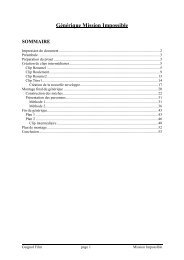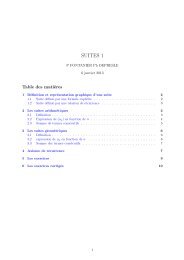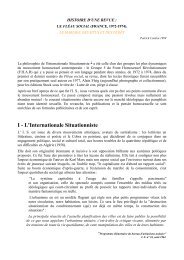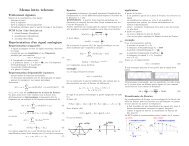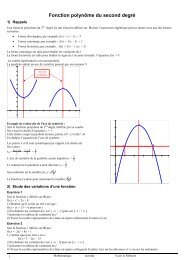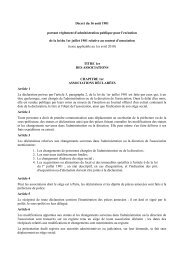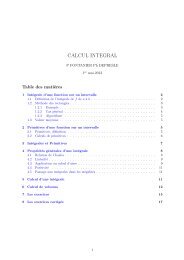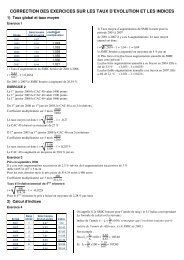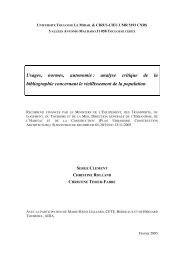internationalisation in science in the prism of bibliometric indicators
internationalisation in science in the prism of bibliometric indicators
internationalisation in science in the prism of bibliometric indicators
You also want an ePaper? Increase the reach of your titles
YUMPU automatically turns print PDFs into web optimized ePapers that Google loves.
89% <strong>of</strong> output <strong>in</strong> 1991, dropp<strong>in</strong>g regularly to 85% <strong>in</strong> 200-2001 11 . The<br />
second decile <strong>in</strong>creases its share, from 8 to 11%, so does <strong>the</strong> third<br />
decile. A syn<strong>the</strong>tic <strong>in</strong>dicator <strong>of</strong> <strong>the</strong> cumulated distribution, <strong>the</strong> G<strong>in</strong>i<br />
<strong>in</strong>dex, also shows this slow and regular down-trend <strong>of</strong> concentration<br />
(0.92 to 0.90), a trend confirmed by <strong>the</strong> coefficient <strong>of</strong> variation<br />
(CV=standard deviation/ mean).<br />
Is this observation confirmed on citation distribution? In fact we<br />
might observe an <strong><strong>in</strong>ternationalisation</strong> <strong>of</strong> competition which eventually<br />
re<strong>in</strong>forces Mat<strong>the</strong>w effects and acquired positions, for example<br />
conced<strong>in</strong>g significant new publication markets for newcomers, but much<br />
smaller opportunities <strong>in</strong> <strong>the</strong> citation market still dom<strong>in</strong>ated by a few<br />
ma<strong>in</strong>stream actors. Internationalisation has a completely different<br />
mean<strong>in</strong>g if it covers an <strong>in</strong>creas<strong>in</strong>g concentration <strong>of</strong> scientific power or<br />
at <strong>the</strong> opposite if it yields, through transfers <strong>of</strong> competencies, a more<br />
equal distribution <strong>of</strong> visibility. Though concentration rema<strong>in</strong>s very<br />
high (still higher, as expected, than for publications), <strong>the</strong> ten major<br />
cited countries represented 95% <strong>in</strong> 1991 and 92% <strong>in</strong> 2000/ 2001, aga<strong>in</strong>st<br />
with a ra<strong>the</strong>r steady trend. G<strong>in</strong>i <strong>in</strong>dexes and CV confirm <strong>the</strong> slow but<br />
real <strong>in</strong>crease <strong>of</strong> evenness.<br />
b) ma<strong>in</strong>stream vs. emerg<strong>in</strong>g countries.<br />
We may have a look at several sets <strong>of</strong> countries <strong>in</strong>clud<strong>in</strong>g more<br />
active or more productive countries. We paid attention to follow<strong>in</strong>g<br />
perimeters: OECD, OECD plus countries with largest output (29<br />
countries) noted OECD+, plus a tentative "ma<strong>in</strong>stream" perimeter (noted<br />
OECD- 12 ).<br />
OECD (<strong>in</strong> its current perimeter, retropolated) represented 85% <strong>of</strong><br />
world publication <strong>in</strong> 1991 vs. 83% <strong>in</strong> 2000/2001, slight contraction<br />
confirmed by citation shares (95%-93%).<br />
"Ma<strong>in</strong>stream" countries accounted for 83% <strong>of</strong> publications <strong>in</strong> 1991 and<br />
79% <strong>in</strong> 2000/2001 (95%-92% <strong>of</strong> citations). The "Emerg<strong>in</strong>g" class<br />
practically ga<strong>the</strong>rs <strong>the</strong> difference, jump<strong>in</strong>g from 15% to 18% (citations<br />
5%-8%). "Periphery" rema<strong>in</strong>s marg<strong>in</strong>al and stable.<br />
Among a group <strong>of</strong> major countries (OECD current perimeter + countries<br />
with strongest output <strong>in</strong> <strong>the</strong> decade), concentration is fall<strong>in</strong>g more<br />
rapidly (G<strong>in</strong>i 0.71 - 0.65, citations 0.79-0.75). The picture is similar<br />
for OECD alone (0.73 - 0.68).<br />
c) EU<br />
If we turn now to EU15, <strong>the</strong> world share is slightly grow<strong>in</strong>g (31 to<br />
33%). With<strong>in</strong> EU15, G<strong>in</strong>i on publications looses four po<strong>in</strong>ts over <strong>the</strong><br />
period (0.58-0.54) and three po<strong>in</strong>ts on citations (0.61-0.58).<br />
d) global picture<br />
11<br />
source <strong>of</strong> <strong>in</strong>dicators: INRA-Lereco; <strong>of</strong> output figures: OST, based on ISI ICF<br />
database.<br />
12<br />
"Ma<strong>in</strong>stream" class has been def<strong>in</strong>ed as OCDE, plus Israel, m<strong>in</strong>us overlaps with an<br />
"Emerg<strong>in</strong>g" class (Europe: candidate countries, Turkey; Lat<strong>in</strong> America: Mexico, Chile,<br />
Argent<strong>in</strong>a, Brazil; Africa: South Africa; Asia: Ch<strong>in</strong>a, India, Taiwan, S<strong>in</strong>gapore,<br />
South Korea). "Peripheral" class groups o<strong>the</strong>r countries.



